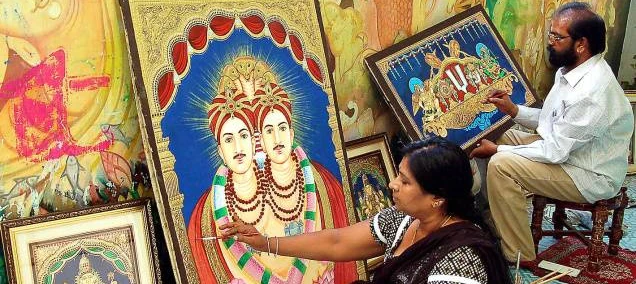Seldom, people forget the vastness and diversity of India. Each state; each district of the glorious nation is known for their exquisite cuisine, serene landscapes, and of course myriad art forms. Whether it is the Sohrai paintings of Jharkhand or the Zardozi embroidery of Uttar Pradesh, India boasts a rich culture; a melting pot. An awe-inspiring classical style, which emerged from the city of Thanjavur, Tamil Nadu is Thanjavur paintings, anglicized to Tanjore paintings. These paintings are known to locals as ‘Palagai Padam,’ which translates to picture on a wooden plank. This style was given the Geographical Indication tag by the Government of India in 2007-08.
The Origins of Thanjavur Paintings
The earliest instance of Thanjavur paintings can be seen on the walls of the 11th-century Chola Brihadeeswarar temple. Earlier the Thanjavur painters lived and worked under the Vijayanagara dynasty. However, with the dynasty’s defeat in the 16th century, they migrated to Thanjavur, where they assimilated the local culture, backed by the Nayak empire. In addition to religious figures, the Thanjavur paintings made at the time also depicted coronations and battle victories.
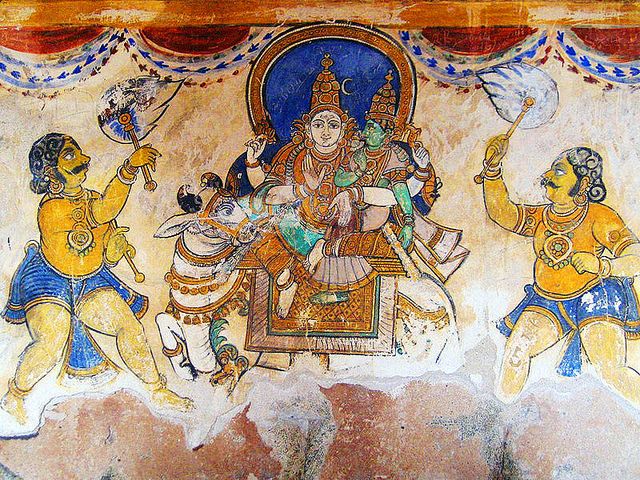
It reached its peak during the 18th century with the Maratha reign. To make it more astonishing and royal, the Maratha artisans incorporated glass beads, gesso work, gold foils, and precious stones, bringing the Thanjavur paintings to their glory. Soon the Britishers occupied Southern India. The Thanjavur paintings made during this time were portable and appealed to Western sensibilities. As opposed to their predecessors, the new style depicted the characters more realistically. The British officers commissioned the artists to make these paintings as souvenirs.
Characteristics of Thanjavur Paintings
Thanjavur paintings were often a tribute and praise to the numerous gods, goddesses, and saints of Hindu mythology. They also depict scenes from Hindu Puranas, Sthala Puranas, and other holy scriptures. Due to their religious nature, they are a staple in most South Indian households, temples, and religious settings. They act not only as a symbol of wealth and culture but devotion as well. There are a few Thanjavur paintings which narrate the religious rituals and life of the Sikhs, Jains, Muslims, and other religions.
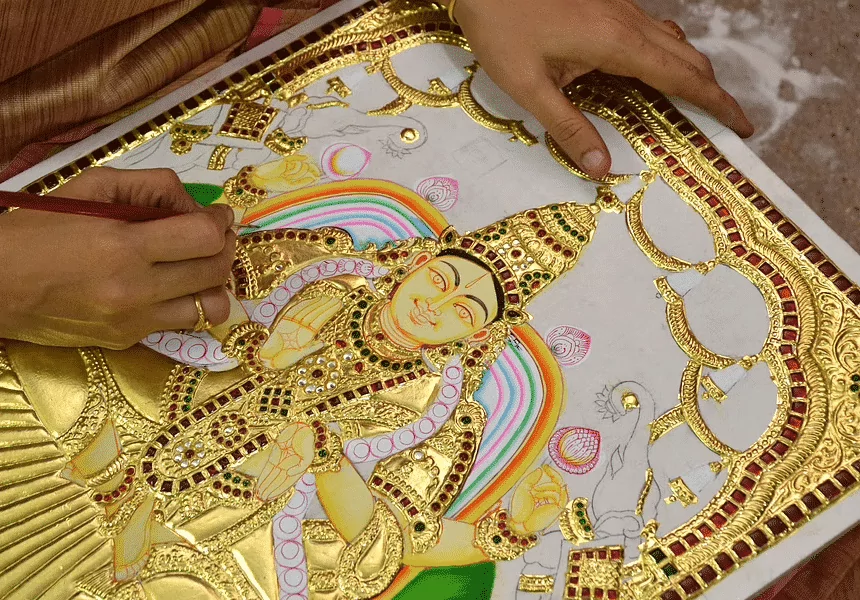
The Thanjavur god paintings are typically adorned with gold leaves. The main character is always bestowed centre stage, with subordinate characters surrounding them. Gold is placed at the embossed part of the canvas, which imbues a certain depth and adds a dimension to the painting. The use of precious and semi-precious stones is also rampant. While the earlier Thanjavur paintings were embellished with Kundan stone, contemporary practitioners have set their eyes on the Swarovski crystals to impart charm and elegance to the paintings. The painting is always housed within a golden archway; a frame called ‘Prabhavali’
Thanjavur Painting Materials
The Thanjavur paintings are the definition of upholding tradition. Each material is carefully chosen to keep up with this tradition. However, accessibility, availability, and affordability have led to an evolution of Thanjavur painting materials. Despite these challenges, one will observe the immaculate use of the following items.
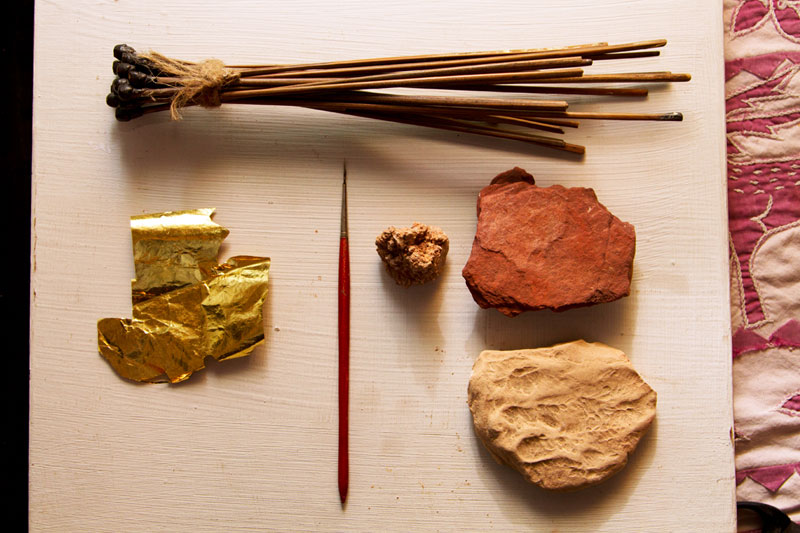
- Gemstones: The gemstones, especially Kundan stones are arranged carefully to create intricate patterns and designs. It may also use rubies, diamonds, pearls, lace, glass beads, and cut glass.
- Gesso: Gesso is a concoction of edible gum, limestone, and chalk powder usually applied with a brush or a cone. It aids in embossing the canvas. Contemporary artists have commenced the use of zinc oxide with a water-soluble adhesive.
- Gold: Gold is usually applied to the embossed area in the form of sheets or leaves. The quality of the gold can go up to 24 karats.
- Paint: Earlier natural dyes, foraged from vegetables and minerals were used. At present, the artists use poster paint to imbibe vibrancy into the Thanjavur paintings.
- Wooden Board: The wooden board serves as the canvas of the Thanjavur paintings. Alternatively, the painting may be drawn over a cloth and plastered on a wooden board.
Making a DIY Painting Using A Thanjavur Painting Kit
Thanjavur paintings have captivated the masses for ages. Despite being a testament to artistic fervour and talent, you can easily procure a simple yet effective Thanjavur painting kit online. These kits come with a premade drawing, a wooden plank, a dry gesso, gold leaves, poster paints, and gemstones. If you have one at your hand, you must follow the steps given below to make an exquisite painting yourself.
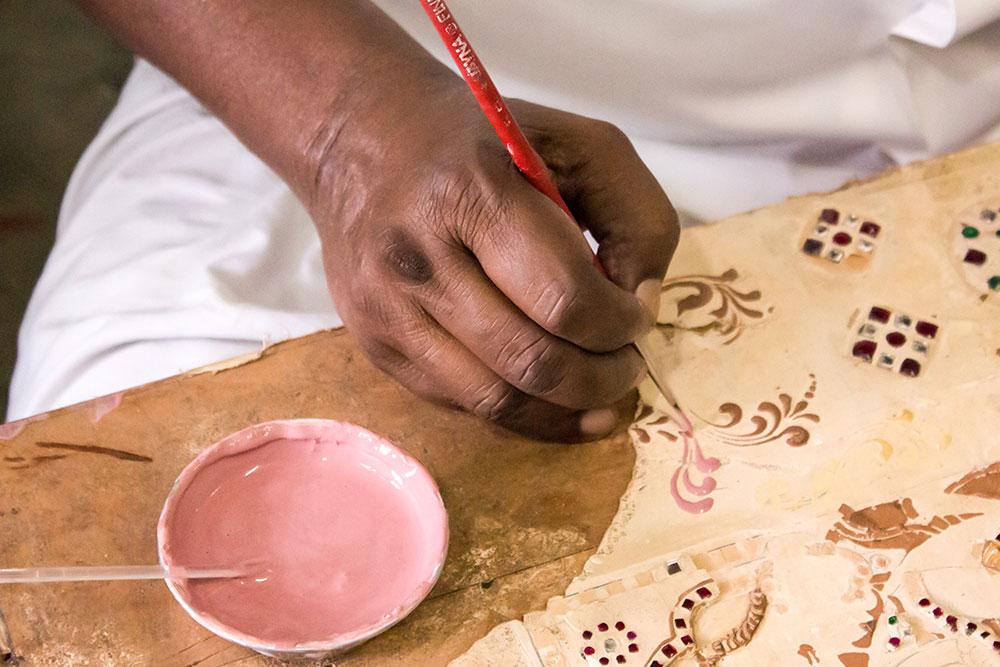
- Paste the sketch over the wooden canvas.
- Make the gesso solution by mixing the powder with a little water. Apply it to the drawing with the paintbrush. Make sure to give the painting depth and dimension for an embossed effect.
- Using the poster paint color the relief works in bright and vibrant hues.
- Add the gold leaves to the raised surfaces.
- Using glue, add the gemstones in patterns. They are usually reserved for the ornaments, so paste them onto the crown or jewellery.
Et Voila! You have a magnificent Thanjavur painting in your hands. You may hang it in your living room or put it in a temple; the right place for the painting.
Image Courtesy – iTokri
10 Famous Artists Who Worked for Gita Press and Leela Chitra Mandir


